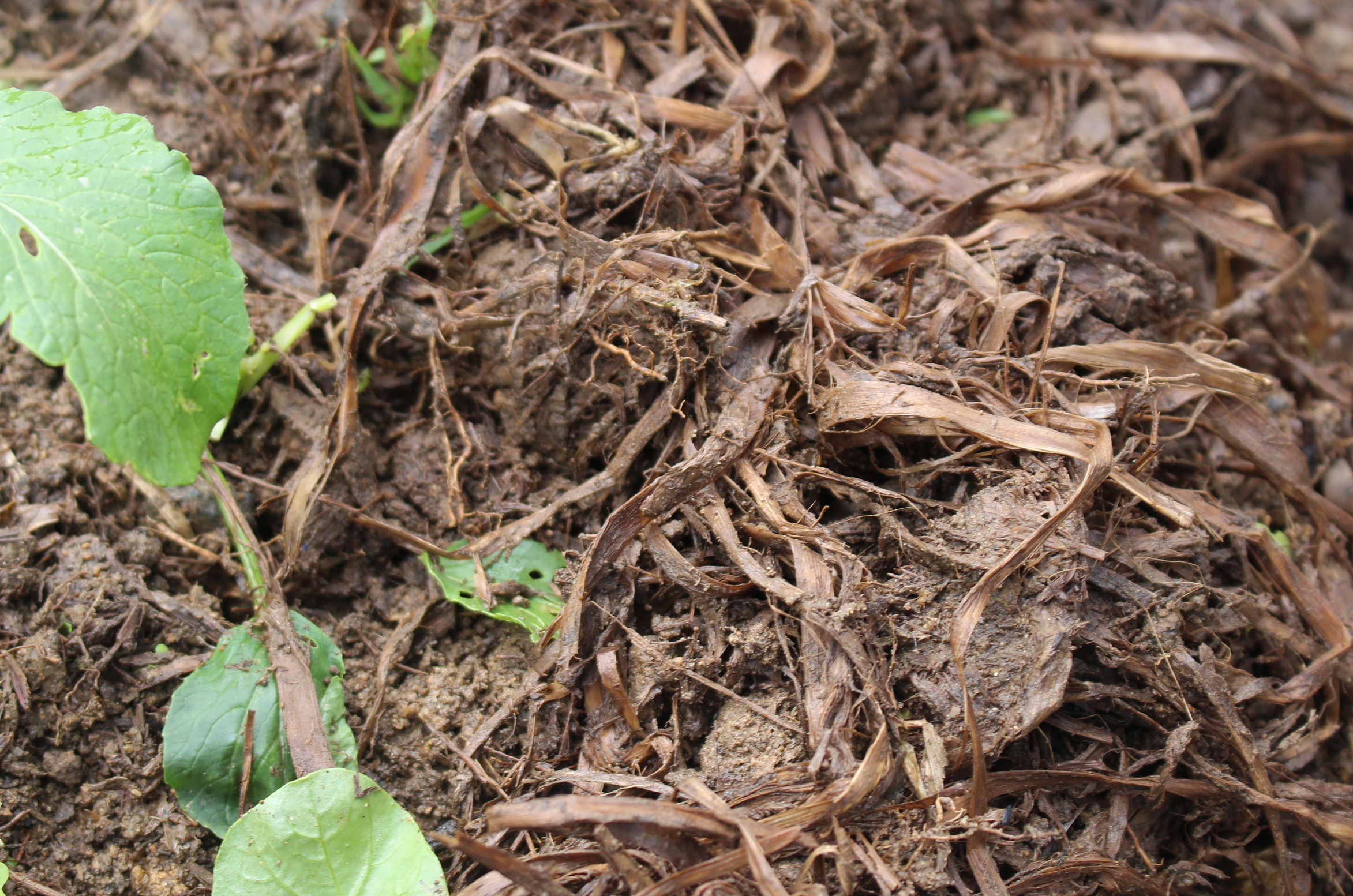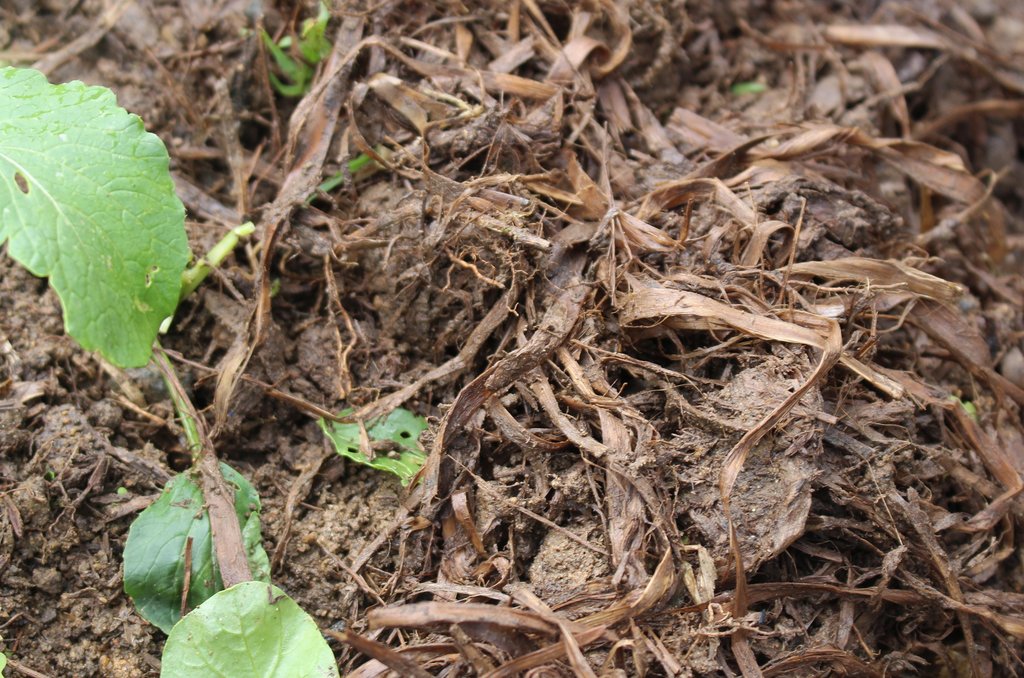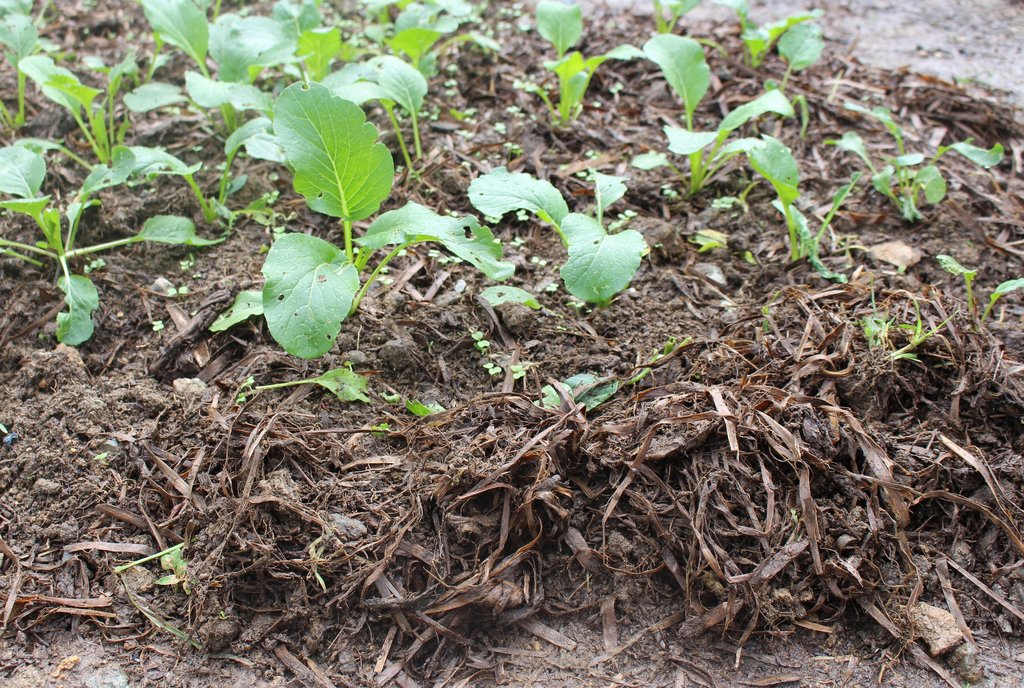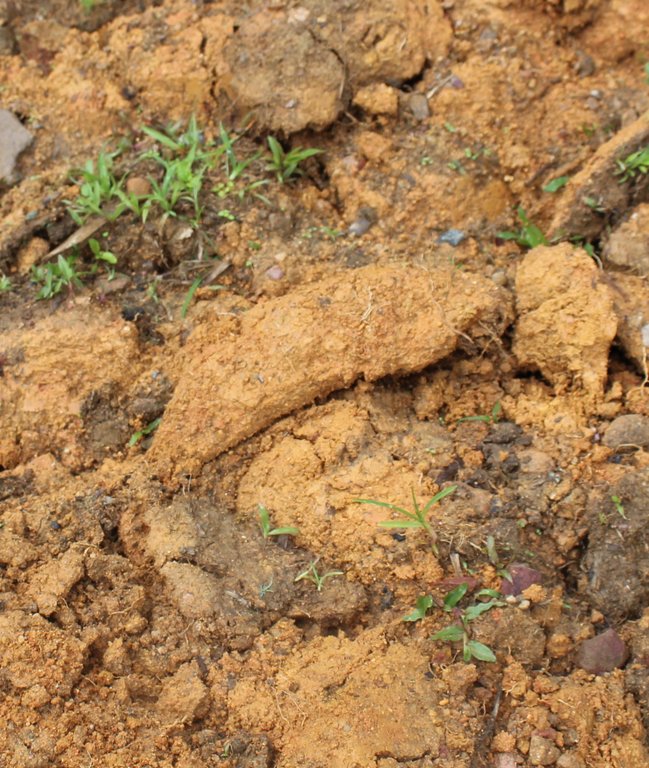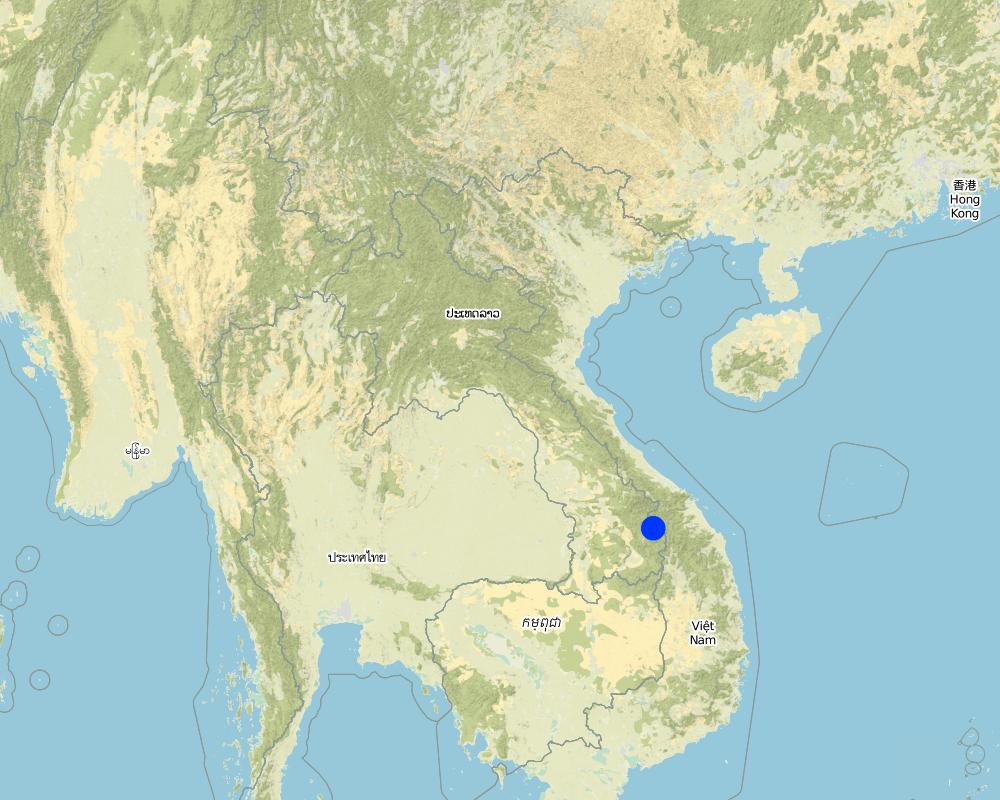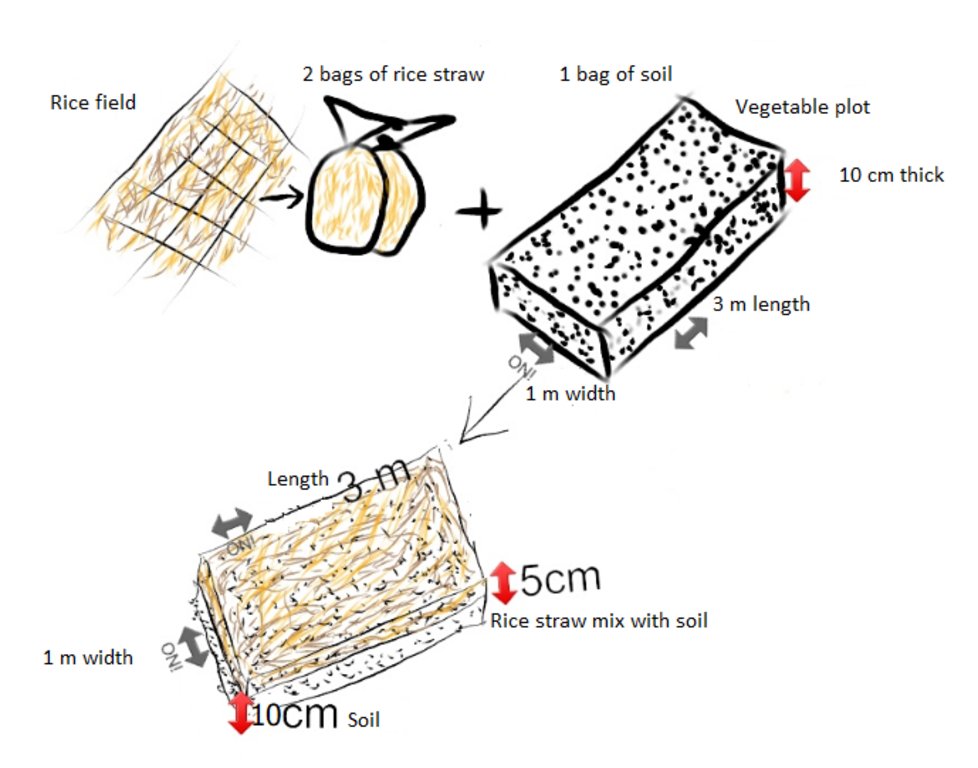ເຕັກນິກ ການເຮັດຝຸ່ນເຟືອງ ເພື່ອປັບປຸງດິນ ໃນພື້ນທີ່ປຸກຜັກສວນຄົນ [Lao People's Democratic Republic]
- Creation:
- Update:
- Compiler: Bounthanom Bouahom
- Editor: kang phanvongsa
- Reviewers: Nivong Sipaseuth, Nicole Harari
technologies_2061 - Lao People's Democratic Republic
View sections
Expand all Collapse all1. General information
1.2 Contact details of resource persons and institutions involved in the assessment and documentation of the Technology
Key resource person(s)
land user:
ລິນນະສຸກ ສຸດາພອນ
030 9543425 / 020 98587726
ບ້ານ ດາກຕະອອກນ້ອຍ ເມືອງ ດາກຈືງ ແຂວງ ເຊກອງ
Lao People's Democratic Republic
Name of project which facilitated the documentation/ evaluation of the Technology (if relevant)
Scaling-up SLM practices by smallholder farmers (IFAD)Name of the institution(s) which facilitated the documentation/ evaluation of the Technology (if relevant)
National Agriculture and Forestry Research Institute (NAFRI) - Lao People's Democratic Republic1.3 Conditions regarding the use of data documented through WOCAT
When were the data compiled (in the field)?
05/04/2017
The compiler and key resource person(s) accept the conditions regarding the use of data documented through WOCAT:
Ja
1.4 Declaration on sustainability of the described Technology
Is the Technology described here problematic with regard to land degradation, so that it cannot be declared a sustainable land management technology?
Nee
2. Description of the SLM Technology
2.1 Short description of the Technology
Definition of the Technology:
ເຕັກນິກ ການເຮັດຝຸ່ນເຟືອງ ໂດຍໃຊ້ເສດເຟືອງທີ່ເນົ່າເປື່ອຍ ແມ່ນແນວຄວາມຄິດລິເລີ່ມ ໂດຍຊາວກະສິກອນເອງ ຊຶ່ງເປັນເຕັກນິກປັບປຸງດິນ ໃນພື້ນທີ່ ປູກຜັກສວນຄົວ ຊຶ່ງເຮັດໃຫ້ດິນມີຄວາມອຸດົມສົມບູນ ເປັນການເພີ່ມຜົນຜະລິດຜັກ ໃຫ້ສູງຂຶ້ນ ແລະ ເພີ່ມຄວາມຫຼາກຫຼາຍ ຂອງຊະນິດຜັກທີ່ປູກ ໃນພື້ນທີ່ປູກຜັກສວນຄົວ ເພື່ອຄຳ້ປະກັນສະບຽງອາຫານ.
2.2 Detailed description of the Technology
Description:
ເຕັກນິກການເຮັດຝຸ່ນເຟືອງ ແມ່ນເປັນເຕັກນິກ ທີ່ໄດ້ລິເລີ່ມ ໂດຍຜູ້ນໍາໃຊ້ທີ່ດິນ ຢຸ່ບ້ານດາກຕະອອກນ້ອຍ ເມືອງດາກຈືງ ແຂວງເຊກອງ ສປປລາວ ຊື່ງຜູ້ນໍາໃຊ້ທີ່ດິນ ແມ່ນໄດ້ລິເລີ່ມ ທົດລອງ ຄົ້ນຄິດເຮັດຝຸ່ນເຟືອງ ໃນປີ 2014 ເນື່ອງຈາກວ່າ ໃນເມື່ອກ່ອນ ຜູ້ນໍາໃຊ້ທີ່ດິນ ເຄີຍໃຊ້ພຽງແຕ່ ຝຸ່ນຄອກ (ຂີ້ງົວ ແລະ ຂີ້ຄວາຍ) ເພື່ອປັບປຸງດິນ ໃນພື້ນທີ່ປູກຜັກສວນຄົວ ແຕ່ຜູ້ນໍາໃຊ້ດິນ ກໍ່ຍັງໄດ້ພົບບັນຫາ ບົ້ງຫຼາຍ ແລະ ເກີດມີເພ້ຍ ຢູ່ໃນສວນຜັກ ສົ່ງຜົນກະທົບ ເຮັດໃຫ້ຜົນຜະລິດຜັກບໍ່ງາມ ແລະ ບໍ່ສາມາດ ຂາຍເປັນສິນຄ້າໄດ້. ດັ່ງນັນ, ຜູ້ນໍາໃຊ້ທີ່ດິນ ຈື່ງມີແນວຄວາມຄິດ ລິເລີ່ມ ທົດລອງ ເກັບເອົາເຟືອງ ທີ່ໄດ້ຈາກນາຕົນເອງ ພາຍຫຼັງ ການເກັບກ່ຽວເຂົ້າ ໃນເດືອນຕຸລາ ທີ່ປະໄວ້ປະມານ 4 ຫຼື 5 ເດືອນ ຈື່ງໄປເກັບເອົາເຟືອງທີ່ເປື່ອຍຈາກນາ ມາໃສ່ພື້ນທີ່ປູກຜັກ ແລະ ໄດ້ສັງເກດເຫັນວ່າ ພື້ນທີ່ດັ່ງກ່າວນັ້ນ ດິນມີຄວາມອຸດົມສົມບູນຂຶ້ນ ທີ່ສົ່ງດີເຮັດໃຫ້ ດິນມີຄວາມຊຸ່ມຊຶ່ນ ແລະ ເພີ່ມສານອາຫານໃນດິນ. ດັ່ງນັ້ນ, ຜູ້ນຳໃຊ້ທີ່ດິນ ຈຶ່ງໄດ້ທ້ອນເຟືອງໄວ້ເປັນກອງ ຢູ່ທົ່ງນາ ພາຍຫຼັງ ສຳເລັດການເກັບກ່ຽວເຂົ້ານາ ເພື່ອເປັນການບົ່ມເຟືອງໃຫ້ເສດເຟືອງເນົ່າເປື່ອຍ ກ່ອນນຳມາໃຊ້. ໂດຍປົກກະຕິແລ້ວ, ຜູ້ນຳໃຊ້ທີ່ດິນ ນຳເອົາເສດເຟືອງ ມາເຮັດຝຸ່ນເຟືອງ ຈຳນວນ 2 ຄັ້ງ ຕໍ່ ປີ. ໃນຄັ້ງທີ່ 1 ແມ່ນເຮັດໃນເດືອນຕຸລາ ພາຍຫຼັງເກັບກ່ຽວເຂົ້ານາ ໃນຊ່ວງທີ່ຝົນບໍ່ໍຕົກຫຼາຍ ແລະ ໃນຄັ້ງທີ່ 2 ແມ່ນເຮັດໃນເດືອນມັງກອນ ເຖິງ ເດືອນກຸມພາ. ວັດຖຸດິບ ທີ່ສຳຄັນ ໃນການເຮັດຝຸ່ນເຟືອງ ແມ່ນເສດເຟືອງ ແລະ ດິນ ເພື່ອປະສົມເຂົ້າກັນ. ສຳລັບອຸປະກອນ ກໍ່ມີພຽງແຕ່ກ່ຽວເຂົ້າ ໄວ້ຕັດເຟືອງ, ກະສອບ ໃສ່ເສດເຟືອງ ແລະ ສຽມ ເພື່ອໃຊ້ເຂົ້າໃນການກະກຽມ ພື້ນທີ່ປູກຜັກ. ວິທີການເຮັດຝຸ່ນເຟືອງ ແມ່ນນຳເອົາເສດເຟືອງ ຈຳນວນ 2 ກະສອບ (ປະມານ 20 ກິໂລກຣາມ) ແລະ ປະສົມເຂົ້າກັບດິນ 1 ກະສອບ (10 ກິໂລກຣາມ) ແລ້ວກໍ່ສາມາດນຳໄປໃຊ້ຄຸມໜານປູກຜັກ ທີ່ໄດ້ກະກຽມດິນໄວ້ເລີຍ (ກ່ອນເອົາເບ້ຍຜັກມາບົງ). ຫຼັງຈາກ, ການນໍາໃຊ້ຝຸ່ນເຟືອງ ຜູ້ນຳໃຊ້ທີ່ດິນ ເຫັນວ່າ ຜັກສາມາດ ຂະຫຍາຍຕົວໄດ້ດີ ໂດຍບໍ່ມີສັດຕູພືດ ຫຼື ແມງໄມ້ລົບກວນ. ດິນໄດ້ຄ່ອຍໆປ່ຽນເປັນສີດຳເຂັ້ມ ຂື້ນກວ່າເກົ່າ ເຊິ່ງເປັນຕົວຊີ້ບອກ ຂອງຄວາມອຸດົມສົມບູນ ຂອງດິນ. ສົ່ງຜົນເຮັດໃຫ້ ຜະລິດຜັກເພີ່ມຂື້ນ ແລະ ຊາວກະສິກອນ ຍັງສາມາດ ປູກພືດຜັກ ໄດ້ຫຼາຍຊະນິດ ລວມທັງ ຜັກບົ່ວ ແລະ ຜັກຫອມປ້ອມ ຊື່ງກ່ອນຫນ້ານີ້ ບໍ່ສາມາດປູກໄດ້. ໃນປະຈຸບັນ, ຜູ້ນຳໃຊ້ທີ່ດິນ ສາມາດສ້າງແຫຼ່ງລາຍຮັບ ໃນຄອບຄົວ ໂດຍການຂາຍຜັກ. ນອກຈາກນັ້ນ, ການນໍາໃຊ້ຝຸ່ນເຟືອງ ຍັງສາມາດປັບຕົວ ເຂົ້າກັບການປ່ຽນແປງ ດິນຟ້າອາກາດ ໂດຍສະເພາະ ແມ່ນໃນຊ່ວງເວລາ ທີ່ມີຝົນຕົກຫນັກ, ເນື່ອງຈາກວ່າ ດິນໄດ້ຖືກປົກຫຸ່ມ ໂດຍເຟືອງ, ມັນສາມາດ ປ້ອງກັນການເຊາະລ້າງ ຂອງໜ້າດິນ ຈາກນ້ຳຝົນ. ໂດຍທົ່ວໄປແລ້ວ, ປະຊາຊົນທ້ອງຖິ່ນ ມີຄວາມພໍໃຈ ກັບເຕັກນິກນີ້ ເພາະວ່າມັນໄດ້ ໃຊ້ພຽງແຕ່ແຮງງານ ໃນການເກັບເຟືອງ ຊື່ງຊາວກະສິກອນ ສາມາດເຮັດໄດ້ ໂດຍທີ່ບໍ່ມີຄ່າໃຊ້ຈ່າຍເພີ່ມເຕີມ. ວິທີການນຳໃຊ້ຝຸ່ນເຟືອງ ກ່ອນອື່ນແມ່ນ ຂຸດໜານຜັກ ເລິກປະມານ 15 ຊັງຕີແມັດ, ຫຼັງຈາກນັ້ນ ໃຊ້ຝຸ່ນເຟືອງທີ່ກຳລັງເປື່ອຍ ມາປະສົມກັບດິນ ທີ່ກຽມໄວ້ ຢູ່ໜານຜັກ ແລ້ວເອົາມາຄຸມດິນ ໜາປະມານ 10 ຊັງຕີແມັດ, ໃນໜານຜັກ ທີ່ມີຂະໜາດຄວາມກວ້າງ 1 ແມັດ, ຍາວ 3 ແມັດ, ແລ້ວຈື່ງເອົາເບ້ຍຜັກລົງປູກ ໄລຍະຫ່າງ ລະຫວ່າງເບ້ຍ ປະມານ 15 ຊັງຕີແມັດ ຫຼື ຫວ່ານແກ່ນພັນຜັກໃສ່ເລີຍ. ຈາກນັ້ນ, ກໍ່ນຳເອົາເຟືອງສົດ ທີ່ກຳລັງເປື່ອຍ ມາປົກປະມານ 5 ຊັງຕີແມັດ ອີກເທື່ອໜື່ງ ເພື່ອປ້ອງກັນນ້ຳຝົນ ຫຼື ເພື່ອຮັກສາຄວາມຊຸ່ມຂອງດິນ. ຊ່ອງຫວ່າງ ລະຫວ່າງ ໜານຜັກຄວນຫ່າງ ປະມານ 20 ຊັງຕີແມັດ ເພື່ອສະດວກໃນການຍ່າງໄປມາ ພາຍໃນເນື້ອທີ່ສວນປູກຜັກ ທັງໝົດ 25 ຕາແມ້ດ.
2.3 Photos of the Technology
2.5 Country/ region/ locations where the Technology has been applied and which are covered by this assessment
Country:
Lao People's Democratic Republic
Region/ State/ Province:
ແຂວງເຊກອງ
Further specification of location:
ບ້ານດາກຕະອອກນ້ອຍ ເມືອງດາກຈືງ
Map
×2.6 Date of implementation
Indicate year of implementation:
2014
If precise year is not known, indicate approximate date:
- less than 10 years ago (recently)
2.7 Introduction of the Technology
Specify how the Technology was introduced:
- through land users' innovation
3. Classification of the SLM Technology
3.1 Main purpose(s) of the Technology
- improve production
- reduce, prevent, restore land degradation
- create beneficial economic impact
3.2 Current land use type(s) where the Technology is applied

Cropland
- Annual cropping
Main crops (cash and food crops):
ຜັກກາດ, ຜັກບົ່ວ, ຫອມປ້ອມ
3.3 Further information about land use
other (e.g. post-flooding):
- ນໍາໃຊ້ນໍ້າລີນ
Number of growing seasons per year:
- 2
3.4 SLM group to which the Technology belongs
- improved ground/ vegetation cover
- integrated pest and disease management (incl. organic agriculture)
- home gardens
3.5 Spread of the Technology
Specify the spread of the Technology:
- evenly spread over an area
If the Technology is evenly spread over an area, indicate approximate area covered:
- < 0.1 km2 (10 ha)
3.6 SLM measures comprising the Technology

agronomic measures
- A2: Organic matter/ soil fertility
3.7 Main types of land degradation addressed by the Technology

chemical soil deterioration
- Cn: fertility decline and reduced organic matter content (not caused by erosion)

physical soil deterioration
- Pu: loss of bio-productive function due to other activities

biological degradation
- Bc: reduction of vegetation cover
- Bq: quantity/ biomass decline
- Bp: increase of pests/ diseases, loss of predators

water degradation
- Ha: aridification
3.8 Prevention, reduction, or restoration of land degradation
Specify the goal of the Technology with regard to land degradation:
- prevent land degradation
- reduce land degradation
4. Technical specifications, implementation activities, inputs, and costs
4.1 Technical drawing of the Technology
4.2 Technical specifications/ explanations of technical drawing
ການກະກຽມ ໝານປູກຜັກ ໂດຍໃຊ້ຈົກຂຸດໜານຜັກ ຄວາມເລິກ ປະມານ 15 ຊັງຕີແມັດ, ຄວາມກວ້າງ 1 ແມັດ ແລະ ຄວາມຍາວ 3 ແມັດ. ເກັບເອົາເສດເຟືອງ ທີ່ກອງໄວ້ຢູ່ທົ່ງນາ ມາປະສົມປົນກັນ ກັບດິນ ໃນອັດຕາສ່ວນ ເຟືອງ 2 ກະສອບ ຕໍ່ກັບ ດິນ 1 ກະສອບ. ຫຼັງຈາກນັ້ນ, ເອົາຝຸ່ນເຟືອງ ມາຄຸມໜ້າດິນ ຂອງໜານຜັກ ໃຫ້ໄດ້ຄວາມສູງ 10 ຊັງຕີແມັດ. ແລ້ວກໍ່ ເອົາເຟືອງເປື່ອຍ ມາຄຸມປົກໄວ້ ໜາປະມານ 5 ຊັງຕີແມັດ. ການເຮັດສວນຜັກ ຢູ່ພື້ນທີ່ ທີ່ມີຄວາມຄ້ອຍຊັນ ປະມານ 1 ຫາ 2%. ຄວາມຫ່າງ ຂອງພືດຜັກ ປະມານ 15 x 15 ຊັງຕີແມັດ, ໄລຍະຫ່າງ ລະຫວ່າງ ໜານຜັກ ແມ່ນ 20 ຊັງຕີແມັດ, ພື້ນທີ່ທັງຫມົດ ຂອງສວນຜັກ ແມ່ນ 25 m2, ຊະນິດ ຜັກທີ່ປູກ ແມ່ນຜັກກາດ, ຜັກຫົມ, ຜັກບົ່ວ ແລະ ຜັກຫອມປ້ອມ ແລະ ຄວາມຫນາແຫນ້ນຂອງພືດ ປະມານ 145 ຕົ້ນ/ໜານ.
4.3 General information regarding the calculation of inputs and costs
Specify how costs and inputs were calculated:
- per Technology area
Indicate size and area unit:
25 m2
other/ national currency (specify):
ກີບ
Indicate exchange rate from USD to local currency (if relevant): 1 USD =:
8000.0
4.4 Establishment activities
| Activity | Type of measure | Timing | |
|---|---|---|---|
| 1. | ການກະກຽມໜານຜັກ | Structural | ຫຼັງເກັບກ່ຽວ (ເດືອນສິງຫາ) |
| 2. | ເກັບເສດເຟືອງ ຈາກທົ່ງນາ | Management | ເດືອນຕຸລາ |
| 3. | ນຳເສດເຟືອງ ມາປົນກັບດິນ | Management | ເດືອນມັງກອນ ເຖິງເດືອນກຸມພາ |
4.5 Costs and inputs needed for establishment
| Specify input | Unit | Quantity | Costs per Unit | Total costs per input | % of costs borne by land users | |
|---|---|---|---|---|---|---|
| Labour | ແຮງງານ ເກັບເສດເຟືອງ | ວັນງານ | 4.0 | 50000.0 | 200000.0 | 100.0 |
| Equipment | ຈົກ | ດວງ | 1.0 | 50000.0 | 50000.0 | 100.0 |
| Equipment | ກະສອບ | ກະສອບ | 30.0 | 2000.0 | 60000.0 | 100.0 |
| Equipment | ສຽມ | ດວງ | 1.0 | 35000.0 | 35000.0 | 100.0 |
| Total costs for establishment of the Technology | 345000.0 | |||||
4.6 Maintenance/ recurrent activities
| Activity | Type of measure | Timing/ frequency | |
|---|---|---|---|
| 1. | ການກະກຽມໜານຜັກ | Structural | ເດືອນສິງຫາ |
| 2. | ເກັບເສດເຟືອງ ຢູ່ທົ່ງນາ | Management | ເດືອນຕຸລາ |
| 3. | ນຳເສດເຟືອງ ມາປົນກັບດິນ | Management | ເດືອນມັງກອນ ເຖິງເດືອນກູມພາ |
4.7 Costs and inputs needed for maintenance/ recurrent activities (per year)
| Specify input | Unit | Quantity | Costs per Unit | Total costs per input | % of costs borne by land users | |
|---|---|---|---|---|---|---|
| Labour | ແຮງງານ ເກັບເສດເຟືອງ | ວັນງານ | 2.0 | 50000.0 | 100000.0 | 100.0 |
| Equipment | ຈົກ | ດວງ | 1.0 | 50000.0 | 50000.0 | 100.0 |
| Equipment | ກະສອບ | ກະສອບ | 30.0 | 2000.0 | 60000.0 | 100.0 |
| Equipment | ສຽມ | ດວງ | 1.0 | 35000.0 | 35000.0 | 100.0 |
| Total costs for maintenance of the Technology | 245000.0 | |||||
4.8 Most important factors affecting the costs
Describe the most determinate factors affecting the costs:
ແຮງງານ ເປັນປັດໃຈສຳຄັນ ໃນການເຮັດເຕັກນີກນີ້ ເນື່ອງຈາກວ່າ ເນ່ືອງຈາກແຮງງານ ໃນຄອບຄົວຈຳກັດ ແລະ ເປັນເວລາດຽວກັນກັບ ການກະກຽມດິນ ເພື່ອສືບຕໍ່ເຮັດນາປີ ໃນລະດູການຕໍ່ໄປ.
5. Natural and human environment
5.1 Climate
Annual rainfall
- < 250 mm
- 251-500 mm
- 501-750 mm
- 751-1,000 mm
- 1,001-1,500 mm
- 1,501-2,000 mm
- 2,001-3,000 mm
- 3,001-4,000 mm
- > 4,000 mm
Specify average annual rainfall (if known), in mm:
870.00
Indicate the name of the reference meteorological station considered:
ສະຖານີ ອຸຕູນິຍົມ ເມືອງດາກຈືງ
Agro-climatic zone
- humid
5.2 Topography
Slopes on average:
- flat (0-2%)
- gentle (3-5%)
- moderate (6-10%)
- rolling (11-15%)
- hilly (16-30%)
- steep (31-60%)
- very steep (>60%)
Landforms:
- plateau/plains
- ridges
- mountain slopes
- hill slopes
- footslopes
- valley floors
Altitudinal zone:
- 0-100 m a.s.l.
- 101-500 m a.s.l.
- 501-1,000 m a.s.l.
- 1,001-1,500 m a.s.l.
- 1,501-2,000 m a.s.l.
- 2,001-2,500 m a.s.l.
- 2,501-3,000 m a.s.l.
- 3,001-4,000 m a.s.l.
- > 4,000 m a.s.l.
Indicate if the Technology is specifically applied in:
- not relevant
5.3 Soils
Soil depth on average:
- very shallow (0-20 cm)
- shallow (21-50 cm)
- moderately deep (51-80 cm)
- deep (81-120 cm)
- very deep (> 120 cm)
Soil texture (topsoil):
- coarse/ light (sandy)
- medium (loamy, silty)
Soil texture (> 20 cm below surface):
- medium (loamy, silty)
Topsoil organic matter:
- medium (1-3%)
5.4 Water availability and quality
Ground water table:
on surface
Availability of surface water:
good
Water quality (untreated):
good drinking water
Is water salinity a problem?
Nee
Is flooding of the area occurring?
Nee
5.5 Biodiversity
Species diversity:
- medium
Habitat diversity:
- medium
5.6 Characteristics of land users applying the Technology
Sedentary or nomadic:
- Sedentary
Market orientation of production system:
- mixed (subsistence/ commercial
Off-farm income:
- 10-50% of all income
Relative level of wealth:
- average
Individuals or groups:
- individual/ household
Level of mechanization:
- manual work
Gender:
- women
Age of land users:
- youth
- middle-aged
5.7 Average area of land owned or leased by land users applying the Technology
- < 0.5 ha
- 0.5-1 ha
- 1-2 ha
- 2-5 ha
- 5-15 ha
- 15-50 ha
- 50-100 ha
- 100-500 ha
- 500-1,000 ha
- 1,000-10,000 ha
- > 10,000 ha
Is this considered small-, medium- or large-scale (referring to local context)?
- small-scale
5.8 Land ownership, land use rights, and water use rights
Land ownership:
- individual, not titled
Land use rights:
- individual
Water use rights:
- open access (unorganized)
- individual
5.9 Access to services and infrastructure
health:
- poor
- moderate
- good
education:
- poor
- moderate
- good
technical assistance:
- poor
- moderate
- good
employment (e.g. off-farm):
- poor
- moderate
- good
markets:
- poor
- moderate
- good
energy:
- poor
- moderate
- good
roads and transport:
- poor
- moderate
- good
drinking water and sanitation:
- poor
- moderate
- good
financial services:
- poor
- moderate
- good
6. Impacts and concluding statements
6.1 On-site impacts the Technology has shown
Socio-economic impacts
Production
crop production
Quantity before SLM:
25 ມັດ
Quantity after SLM:
30 ມັດ
Comments/ specify:
ສານອິນຊີ ໃນດິນ ເພີ່ມຂື້ນ ເຮັດໃຫ້ດິນ ມີຄວາມອຸດົມສົມບູນ ສົ່ງຜົນໃຫ້ ຜົນຜະລິດຜັກ ກໍ່ເພີ່ມຂື້ນ.
crop quality
Comments/ specify:
ກ່ອນຫນ້ານ້ີ ດິນບໍ່ງາມ ສົ່ງຜົນເຮັດໃຫ້ ຄຸນນະພາບ ຂອງຜັກກ່ໍບໍ່ງາມ. ພາຍຫັຼງ ນໍາໃຊ້ຝຸ່ນເຟືອງແລ້ວ ເຫັນວ່າ ດິນມີຄວາມອຸດົມສົມບູນຂື້ນ.
Income and costs
farm income
Comments/ specify:
ຜົນຜະລິດຜັກກຸ້ມກິນ ພາຍໃນຄອບຄົວ ພ້ອມມທັງສາມາດ ຂາຍເປັນສິນຄາ້ ສາມາດສ້າງລາຍຮັບໄດ້
workload
Comments/ specify:
ເປັນການເພີ່ມວຽກ ເນ່ືອງຈາກຕ້ອງ ໄປເກັບເສດເຟືອງ ພາຍຫັຼງ ສໍາເລັດການເກັບກ່ຽວເຂົ້ານາ ແລ້ວມາກອງໄວ້ ເພື່ອເຮັດໃຫ້ເຟືອງເປ່ືອຍດີ ກ່ອນນໍາມາປະສົມກັບດິນ.
Socio-cultural impacts
food security/ self-sufficiency
Comments/ specify:
ມີຜກັ ໄວ້ກິນ ພາຍໃນຄອບຄົວ ແລະ ຍັງສາມາດຂາຍ ເພື່ອສ້າງລາຍຮັບ ໃຫ້ຄອບຄົວ
Ecological impacts
Soil
soil moisture
Comments/ specify:
ເສດເຟືອງ ສາມາດເກັບກັກນໍາ້ໄດ້ ເປັນຢ່າງດີ ພາຍຫັຼງ ຈາກປະສົມເສດເຟືອງເຂົ້າກັບດິນແລວ້ ກ່ໍເຮັດໃຫ້ດິນມີຄວາມຊຸ່ມຊ່ືນ
soil compaction
Comments/ specify:
ໃນເວລາທີ່ຜູ້ໃຊ້ທີ່ດິນ ປະສົມດິນ ດ້ວຍເຟືອງທີ່ເປື່ອຍ ດິນຈະປ່ຽນເປັນສີເຂັ້ມ ແລະ ມີຄວາມຜຸ່ຍຫຼາຍຂື້ນ.
nutrient cycling/ recharge
Comments/ specify:
ເຟືອງ ຈະຖືກຍ່ອຍ ໂດຍໂຕຍ່ອຍສະຫຼາຍເຊັ່ນ: ຂື້ກະເດືອນ ແລະ ຈຸລິນຊີອື່ນໆ ໃນດິນ ໂດຍຜ່ານລໍາໄສ້ ຂອງພວກມັນ ແລະ ຂະບວນການຍ່ອຍສະຫຼາຍນີ້ ສາມາດ ສະໜອງທາດອາຫານສໍາລັບຜັກ.
6.3 Exposure and sensitivity of the Technology to gradual climate change and climate-related extremes/ disasters (as perceived by land users)
Gradual climate change
Gradual climate change
| Season | Type of climatic change/ extreme | How does the Technology cope with it? | |
|---|---|---|---|
| annual temperature | increase | moderately | |
| seasonal temperature | dry season | decrease | well |
| annual rainfall | increase | moderately | |
| seasonal rainfall | wet/ rainy season | increase | moderately |
Climate-related extremes (disasters)
Meteorological disasters
| How does the Technology cope with it? | |
|---|---|
| local hailstorm | moderately |
Climatological disasters
| How does the Technology cope with it? | |
|---|---|
| extreme winter conditions | not well |
Biological disasters
| How does the Technology cope with it? | |
|---|---|
| insect/ worm infestation | very well |
Other climate-related consequences
Other climate-related consequences
| How does the Technology cope with it? | |
|---|---|
| reduced growing period | very well |
6.4 Cost-benefit analysis
How do the benefits compare with the establishment costs (from land users’ perspective)?
Short-term returns:
neutral/ balanced
Long-term returns:
positive
How do the benefits compare with the maintenance/ recurrent costs (from land users' perspective)?
Short-term returns:
slightly positive
Long-term returns:
positive
6.5 Adoption of the Technology
- single cases/ experimental
Of all those who have adopted the Technology, how many have did so spontaneously, i.e. without receiving any material incentives/ payments?
- 90-100%
6.6 Adaptation
Has the Technology been modified recently to adapt to changing conditions?
Nee
6.7 Strengths/ advantages/ opportunities of the Technology
| Strengths/ advantages/ opportunities in the land user’s view |
|---|
| ສາມາດ ປັບປຸງດິນ ເຮັດໃຫ້ດິນມີອຸດົມສົມບູນ |
| ຜົນຜະລິດເພີ່ມຂ້ຶນ ແລະ ຄຸນນະພາບ ຂອງພືດຜັກກໍ່ງາມ |
| ການເພີ່ມຂື້ນ ຂອງຈຸລິນຊີ ທີ່ເປັນປະໂຫຍດ ເປັນຕົ້ນແມ່ນ ຂີ້ກະເດືອນ |
| Strengths/ advantages/ opportunities in the compiler’s or other key resource person’s view |
|---|
| ເຟືອງເຮັດໃຫ້ດິນມີ ຄວາມຜຸຜຸ່ຍຫຼາຍຂື້ນ ເຮັດໃຫ້ຮາກພືດເຂົ້າໄປໃນດິນງ່າຍຂື້ນ |
| ນ້ໍາຊືມຜ່ານດິນ ໄດ້ດີຂື້ນ ແລະ ເຮັດໃຫ້ ດິນມີຄວາມຊຸ່ມຫຼາຍຂື້ນ |
6.8 Weaknesses/ disadvantages/ risks of the Technology and ways of overcoming them
| Weaknesses/ disadvantages/ risks in the land user’s view | How can they be overcome? |
|---|---|
| ເສດເຟືອງ ທີ່ໄດ້ຈາກທົ່ງນາ ແມ່ນມີຈຳກັດ ແລະ ມີເປັນຍາມ (ສາມາດ ເກັບເຟືອງໄດ້ພຽງແຕ່ພາຍຫຼັງເກັບກ່ຽວເຂົ້ານາ) |
7. References and links
7.1 Methods/ sources of information
- field visits, field surveys
2
- interviews with land users
2
Links and modules
Expand all Collapse allLinks
No links
Modules
No modules


